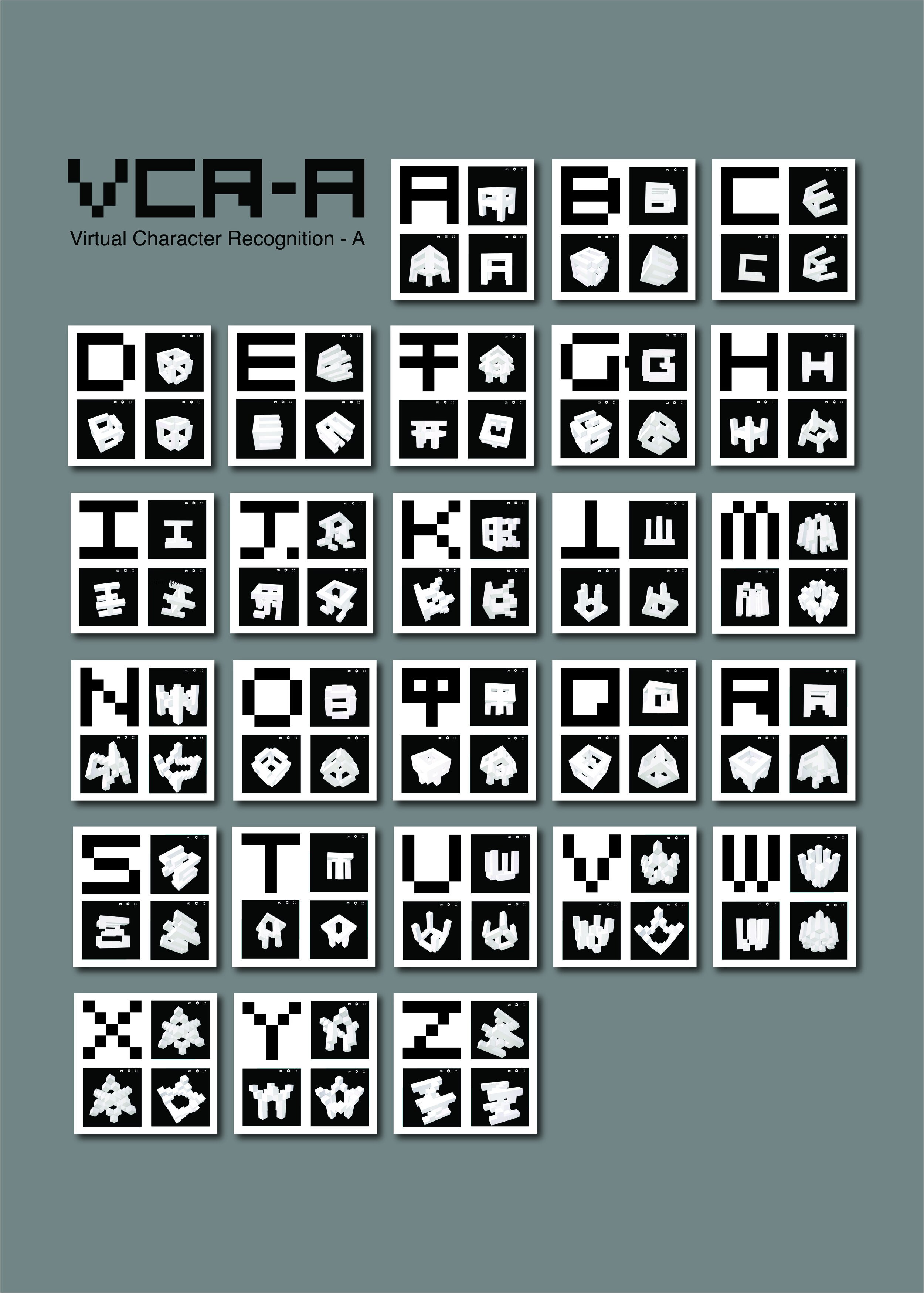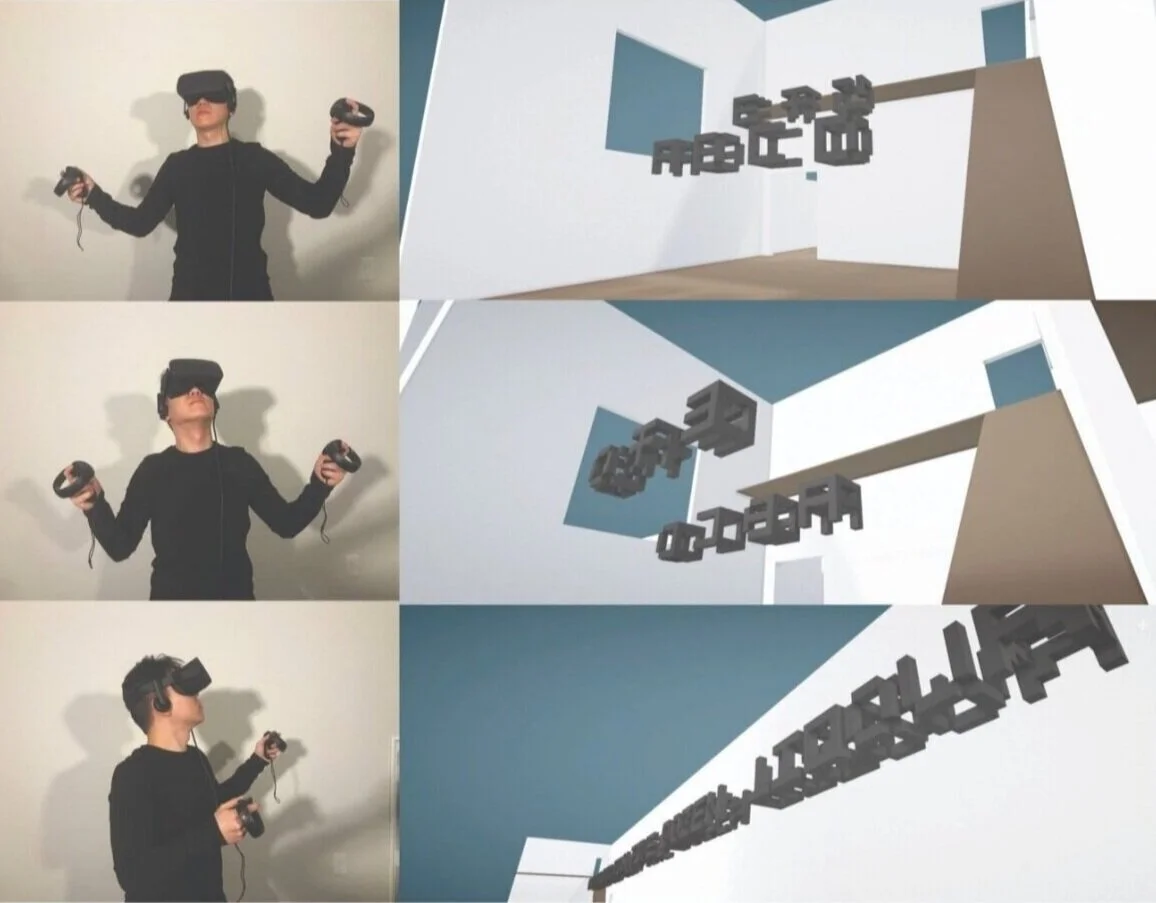Virtual Character Recognition (VCR A/B)
Writing has been a fundamental tool for expressing and communicating ideas throughout human history. From the development of cuneiform over 3000 years ago to the present day, writing systems have continuously evolved to better capture and share thoughts, intentions, and visions. As technology advances, so too must our writing systems—particularly within virtual environments, where new dimensions of interaction and expression are possible.
Virtual spaces offer opportunities that transcend the limitations of physical writing systems, which are primarily designed for two-dimensional surfaces. Although interactive and coded fonts have started to emerge for use on screens and in print, they still fall short of capturing the full depth and interactivity that virtual reality (VR) enables. In VR, writing can transcend flat surfaces, becoming spatial, dynamic, and immersive.
Rooted in Marshall McLuhan's media philosophy that "the medium is the message" Virtual Character Recognition (VCR A/B) explores how writing—one of humanity’s oldest mediums—must evolve to fully align with the immersive, multi-dimensional characteristics of VR. McLuhan’s assertion that the form of media shapes how messages are understood directly applies to this project, which reimagines writing not just as a passive, linear medium, but as an active, immersive experience in virtual space.
In virtual environments, writing can be something you interact with, navigate through, and experience, rather than merely observe. VCR A/B transforms text into a sensory-driven, dynamic experience that unlocks new creative possibilities. As VR continues to expand its influence across industries like gaming, education, and art, this project highlights the growing need for writing systems designed specifically for virtual environments. By embedding text within three-dimensional spaces, users can engage with language in novel and unprecedented ways.
Virtual Character Recognition A and B (VCR-A/B) is an experimental typeface created for a future where writing systems must function seamlessly in both physical and virtual worlds. Inspired by Adrian Frutiger’s OCR-A/OCR-B typefaces, VCR-A/B is optimized for legibility from multiple angles—top, bottom, left, and right—catering to the fluidity of virtual environments.
Unlike traditional typefaces, which are primarily composed of lines, VCR-A/B uses a poly-symmetric cube to form its recognizable characters. It is a monospaced font that incorporates depth into the design of each letter, enhancing its three-dimensionality. While VCR-A/B retains features common to two-dimensional typefaces, such as color, stroke width, and plane width, it introduces dynamic view interaction, where the angle of viewing is a key element. The typeface is not merely seen orthogonally to the reading surface but is instead experienced from multiple perspectives.
More than just a font, VCR-A/B offers an immersive and interactive experience. In virtual environments, writing becomes something that users can not only read but also feel and explore in a sensory-rich manner. This typeface pushes the boundaries of what is possible in visual communication, meeting the challenges of a new medium head-on.
In conclusion, as technology progresses and virtual environments become more pervasive, innovative approaches to writing systems are essential. Virtual Character Recognition A and B (VCR-A/B) is one such experiment, optimized for use in virtual spaces. By incorporating dynamic, interactive elements that enhance the immersive experience, VCR-A/B offers a glimpse of the future of visual communication. As we continue to explore the possibilities of virtual spaces, it is exciting to envision how writing systems like VCR-A/B will evolve, reshaping how we communicate and interact with text in immersive environments.
가상 문자 인식 A/B (Virtual Character Recognition A/B)
인류가 문자를 사용해 생각과 의사를 표현한 지 수천 년이 흘렀습니다. 처음의 설형 문자부터 현재에 이르기까지, 우리는 지속적으로 글쓰기 방식을 발전시켜 왔습니다. 이제 기술의 발전에 따라, 글쓰기 역시 변화해야 할 시점에 이르렀습니다. 특히 가상 환경에서는 전통적인 문자 체계로는 다 담아낼 수 없는 새로운 가능성이 열리고 있습니다.
가상 공간은 물리적 세계에서 불가능했던 새로운 차원의 상호작용과 표현 방식을 제공합니다. 하지만 대부분의 글쓰기 도구는 이차원적 표면을 염두에 두고 설계되어 있어, 가상 환경의 깊이와 다차원적 상호작용을 제대로 활용하지 못합니다. 우리가 최근 스크린과 인쇄물에서 인터랙티브 폰트나 코드화된 글꼴을 접할 수 있게 되었지만, 여전히 VR(가상 현실)의 잠재력을 충분히 발휘하지는 못하고 있습니다. VR에서는 글이 단순한 평면을 넘어 공간적으로 확장되고, 동적이며 몰입적인 경험으로 거듭날 수 있습니다.
이 프로젝트 가상 문자 인식 A/B (VCR-A/B)는 미디어 이론가 마셜 맥루한(Marshall McLuhan)의 "미디어는 메시지다(The medium is the message)"라는 철학에 바탕을 두고 있습니다. 맥루한은 매체의 형태가 그 안에 담긴 메시지의 본질을 결정한다고 말했는데, 이는 VR이라는 새로운 미디어에 매우 적합한 개념입니다. VR은 기존의 글쓰기 방식을 넘어, 정보를 전달하는 방식 자체를 재해석해야 할 기회를 제공합니다. 글은 이제 단순히 읽는 것이 아니라, 공간에서 상호작용하며 탐색하는 다차원적인 시스템으로 진화해야 합니다.
이 프로젝트는 인류의 가장 기본적인 소통 수단인 '글쓰기'가 VR의 특성에 맞춰 어떻게 변화할 수 있는지를 탐구합니다. 가상 공간에서의 글쓰기는 시각적 정보로 머물지 않고, 사용자가 상호작용하고 경험할 수 있는 매체가 됩니다. 이렇게 글을 재구성함으로써, 글은 단순한 정보 전달 수단에서 벗어나 몰입적이고 감각적인 경험으로 변모하게 됩니다. 이는 가상 환경이 제공하는 무한한 가능성을 반영하며, 새로운 창의적 표현의 문을 엽니다.
VCR-A/B는 물리적 세계와 가상 세계 모두에서 인식 가능한 새로운 글쓰기 방식을 제안합니다. 이 프로젝트는 아드리안 프루티거(Adrian Frutiger)가 디자인한 OCR-A와 OCR-B 서체에서 영감을 받았습니다. 특히 가상 환경에서 다양한 각도, 예를 들어 상하좌우 어디에서든 글을 쉽게 읽을 수 있도록 가독성을 최적화했습니다.
기존의 서체가 주로 선으로 구성된 반면, VCR-A/B는 다면체 구조를 사용해 문자를 형성합니다. 각 글자는 일정한 간격으로 배치된 모노스페이스 서체로 설계되었으며, 깊이를 더한 입체적 요소를 포함하고 있습니다. 이 서체는 기존의 이차원 서체에서 볼 수 있는 색상, 획의 두께, 평면 너비 등의 특징을 유지하는 동시에, 가상 환경에서는 시야각이 중요해지기 때문에, 다양한 각도에서 동적으로 변하는 글자의 특성을 반영합니다. 따라서, 이 서체는 사용자가 글자를 단순히 정면에서 읽는 것을 넘어, 공간 속에서 경험할 수 있도록 설계되었습니다.
VCR-A/B는 단순한 글꼴이 아닙니다. 이 서체는 가상 환경에서 글을 '읽는' 경험을 넘어, 직접 '느끼고' 탐험할 수 있는 몰입형 인터랙티브 경험을 제공합니다. 이 프로젝트는 새로운 매체가 요구하는 도전에 맞서, 시각적 커뮤니케이션의 경계를 넓히고자 하는 시도입니다.
결론적으로, 기술이 발전함에 따라 가상 환경이 일상 속에서 더욱 중요한 역할을 하게 될 것입니다. 그에 따라, 이러한 새로운 미디어의 가능성을 충분히 활용할 수 있는 혁신적인 글쓰기 시스템이 필요해졌습니다. VCR-A/B는 가상 환경에 최적화된 실험적 서체로, 몰입적 경험을 극대화하는 동적이고 상호작용적인 요소들을 포함하고 있습니다. 가상 공간의 잠재력을 더 깊이 탐구함에 따라, 이처럼 새로운 글쓰기 시스템이 우리가 커뮤니케이션하는 방식을 어떻게 변화시킬지 기대됩니다.










